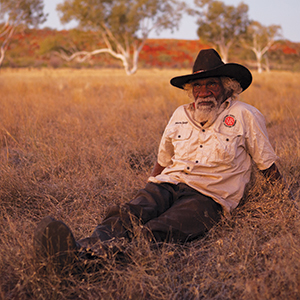Features & Columns
Being There
Intro | Jane Lynch | The Valley | The Warriors | India In A Day | Festival Picks
 'Collisions,' one of the virtual reality films to be shown at this year's Cinequest, centers on the life of an aboriginal farmer in the remote Australian bush.
'Collisions,' one of the virtual reality films to be shown at this year's Cinequest, centers on the life of an aboriginal farmer in the remote Australian bush.
From George Lucas' pioneering special effects studio, Industrial Light & Magic, to Steve Jobs' wild personal gamble, Pixar, the Bay Area has long been home to powerhouses in movie and TV production. But for all the incredible work done in the region, Los Angeles has remained the film capital of the world—while Silicon Valley has served only as a consultancy outpost for the big Hollywood studios.
That is poised to change as more filmmakers adopt virtual reality and augmented reality technologies to tell stories, according to Halfdan Hussey, CEO and co-founder of Cinequest, which this year is expanding its mission statement and rebranding itself as the Cinequest Film & VR Festival.
The 27th annual festival has long been a champion of cutting-edge cinematic advancements. In past years, the festival has showcased digital film technology, online movie distribution and new formats like the Barco Escape three-screen theater projection format. Now Hussey says it is time to bring VR into the fold.
"This is Silicon Valley," he says. "It's the epicenter of VR. I feel like we must be a VR festival."
Also, Hussey adds, the timing is right. With a number of local companies building VR technologies—from specialized omnidirectional cameras to software that helps stitch together VR video into a cohesive whole—there is a growing amount of quality VR content originating right here in Santa Clara County.
"It's really a fantastic time for us to get into the VR space," Hussey says, noting that the technology is still young, but that enough quality work now exists that he and his team felt that both consumers and filmmakers would be interested in learning more about the nascent format. "Now you're seeing movies and VR experiences that really run the gamut."
Short horror films and brief documentary clips are among the best productions in the virtual reality space thus far, Hussey says. "You can get so much empathy in VR," he explains of the format's potential in documentary filmmaking. "It's one thing to talk about people who are in a little town in Africa and see pictures, but to actually feel like you're there with them is something else entirely." And of course, the power of a well-executed thriller is made ever more intense if the viewer feels that he or she is in mortal danger.
For those interested in seeing what is currently being done in the VR space, there's the Virtual Reality Canteen + Gallery, where the curious can view titles like Alter Ego, Fantastic Beasts and Burlap. There is also a slate of Virtual Reality Cinema Programs.
The technology behind animated virtual reality films appear to have a significant advantage at this stage in the VR race for supremacy. Asteroids! is part of the VR Cinema Program 1. It's the second film from Baobab Studios, which was co-founded by writer/director Eric Darnell (Antz, Madagascar). This three-minute animated short is set inside a spaceship with primary colored aliens, robots and control panels. As you watch the aliens move about their capsule, you do feel like a passenger strapped in for the ride. Very little happens though, and while the aliens speak, they don't speak in English and aren't subtitled.
In a cartoon like this, it's not clear what the advantage of working in VR is at this point in time. In an email, a publicist from Baobab Studios wrote this response to that question: "VR allows you to draw the viewer into the movie on more of an emotional level, creating empathy and even compassion for the characters." If there isn't much of a story to tell, this statement is cause for debate. In this regard, VR Cinema Program 5 offers something more emotionally stirring than a videogame template.
Collisions is a five-minute short about an indigenous tribe in the Australian desert. VR provides a disorienting effect in films like this one. Don one of the headsets and you're suddenly transported to another hemisphere. The camera opens up the field of space and moves toward the people standing on the reddened earth. Visually, you're walking with the cinematographer but your actual body is sitting still. For gamers and other viewers who regularly immerse themselves in VR, the adjustment to the new reality may be easier. For those new to the medium, the transition can be dizzying.
Hussey acknowledges there is a long way to go—in part because so few have been trained in using virtual reality technology and because those who are well versed are inventing a brand new set of storytelling conventions as they go. What are the cues that tell a viewer to turn around, look up or look down? Can a romantic comedy work as a VR experience; if so, how? And how do you ensure the sound is realistic enough that it doesn't take the viewer out of the experience?
These are all questions that speakers will attempt to answer in a series of workshops—including seminars on "Cinematic VR" and "Sound Design."
Hussey believes that the tipping point for VR adoption is about a year away: "They're starting to get enough headsets out there, but will audiences have enough quality experience that they're really going to be happy in VR?" His answer as of today is a definite maybe: "We certainly have an abundance at Cinequest, but that has to grow say 10-fold for the consumer to be able to have enough to see and experience in their homes to really make this industry fly."


